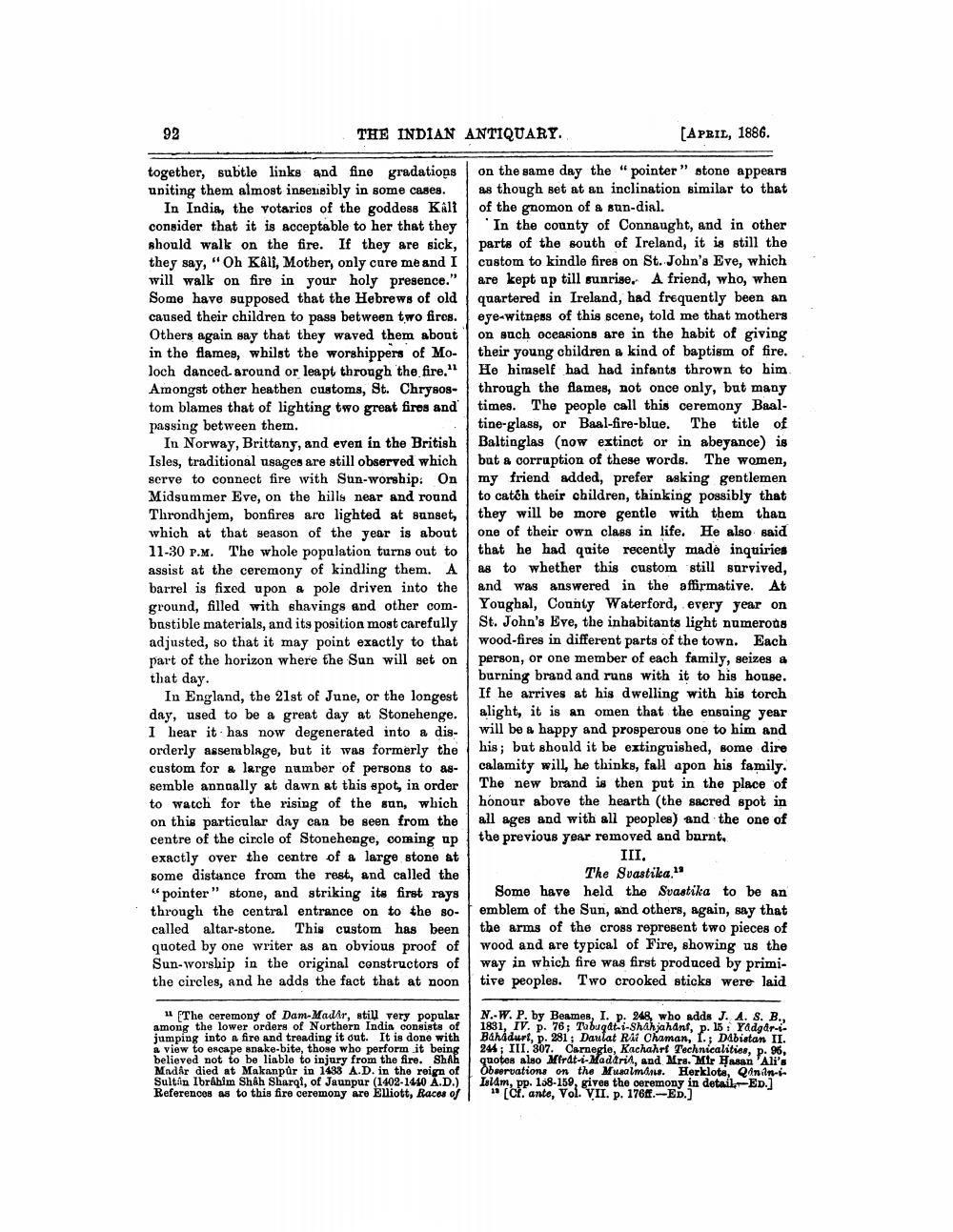________________
92
THE INDIAN ANTIQUARY.
[APRIL, 1886.
together, subtle links and fine gradations on the same day the "pointer" stone appears uniting them almost insensibly in some cases. As though set at an inclination similar to that
In India, the votarios of the goddess Kall of the gnomon of a bun-dial. consider that it is acceptable to her that they 1 'In the county of Connaught, and in other should walk on the fire. If they are sick, parts of the south of Ireland, it is still the they say, "Oh Kali, Mother, only care me and I custom to kindle fires on St. John's Eve, which will walk on fire in your holy presence." are kept up till sunrise. A friend, who, when Some have supposed that the Hebrews of old quartered in Ireland, had frequently been an caused their children to pass between two fires. ege-witness of this scene, told me that mothers Others again say that they waved them about on such oceasions are in the habit of giving in the flames, whilst the worshippers of Mo- their young children a kind of baptism of fire. loch danced around or leapt through the fire." He himself had had infants thrown to him Amongst other heathen customs, St. Chrysos- through the flames, not once only, but many tom blames that of lighting two great fires and times. The people call this ceremony Baalpassing between them.
tine-glass, or Baal-fire-blue. The title of In Norway, Brittany, and even in the British Baltinglas (now extinct or in abeyance) is Isles, traditional usages are still observed which but & corruption of these words. The women, serve to connect fire with Sun-worship: On my friend added, prefer asking gentlemen Midsummer Eve, on the hills near and round to catch their children, thinking possibly that Throndhjem, bonfires are lighted at sunset, they will be more gentle with them than which at that season of the year is about one of their own class in life. He also said 11-30 PM. The whole population turns out to that he had quite recently made inquiries assist at the ceremony of kindling them. A as to whether this custom still survived, barrel is fixed upon a pole driven into the and was answered in the affirmative. At ground, filled with shavings and other com- Youghal, County Waterford, every year on bustible materials, and its position most carefully St. John's Eve, the inhabitants light numerous adjusted, so that it may point exactly to that wood-fires in different parts of the town. Each part of the horizon where the sun will set on person, or one member of each family, seizes a that day.
burning brand and runs with it to his house. In England, the 21st of June, or the longest If he arrives at his dwelling with his torch day, used to be a great day at Stonehenge. alight, it is an omen that the ensuing year I hear it has now degenerated into a dis- will be a happy and prosperous one to him and orderly assemblage, but it was formerly the his; but should it be extinguished, some dire custom for a large number of persons to as
calamity will, he thinks, fall apon his family. semble annually at dawn at this spot, in order The new brand is then put in the place of to watch for the rising of the sun, which honour above the hearth (the sacred spot in on this particular day can be seen from the all ages and with all peoples) and the one of centre of the circle of Stonehenge, coming up the previous year removed and burnt, exactly over the centre of a large stone at
III, some distance from the rest, and called the
The Svastika." "pointer" stone, and striking its first rays Some have held the Svastika to be an through the central entrance on to the so- emblem of the Sun, and others, again, say that called altar-stone. This custom has been the arms of the cross represent two pieces of quoted by one writer as an obvious proof of wood and are typical of Fire, showing us the Sun-worship in the original constructors of way in which fire was first produced by primithe circles, and he adds the fact that at noon tive peoples. Two crooked sticks were laid
# The ceremony of Dam-Madar, still very popular among the lower orders of Northern India consists of jumping into a fire and treading it out. It is done with a view to encape snake bite, those who perform it being believed not to be liable to injury from the fire. Shah Mndar died at Makanpur in 1438 A.D. in the reign of Sultan Ibrahim Shah Sharqi, of Jaunpur (1402-1440 A.D.). Referencos as to this fire ceremony are Elliott, Races of
N.-W. P. by Beames, I. p. 248, who adds J. A. 8. B.. 1831, IV. p. 76; Tubugdt-i-Shahjahdnf, p. 15 Yadgar-i. Bahadurl, p. 281, Daulat RM Chaman, 1. Dabistan II. 244 ; III. 307. Carnegie, Kachahrt Technicalition, p. 96, quotes also Mirdt-i-Madaril, and Mrs. Mir Hasan Ali's Observations on the Musalmans. Horkloti, QaninIslam, pp. 158-159, gives the ceremony in detail-ED]
" (or ante, Vol. VII. p. 1768.-ED.)




